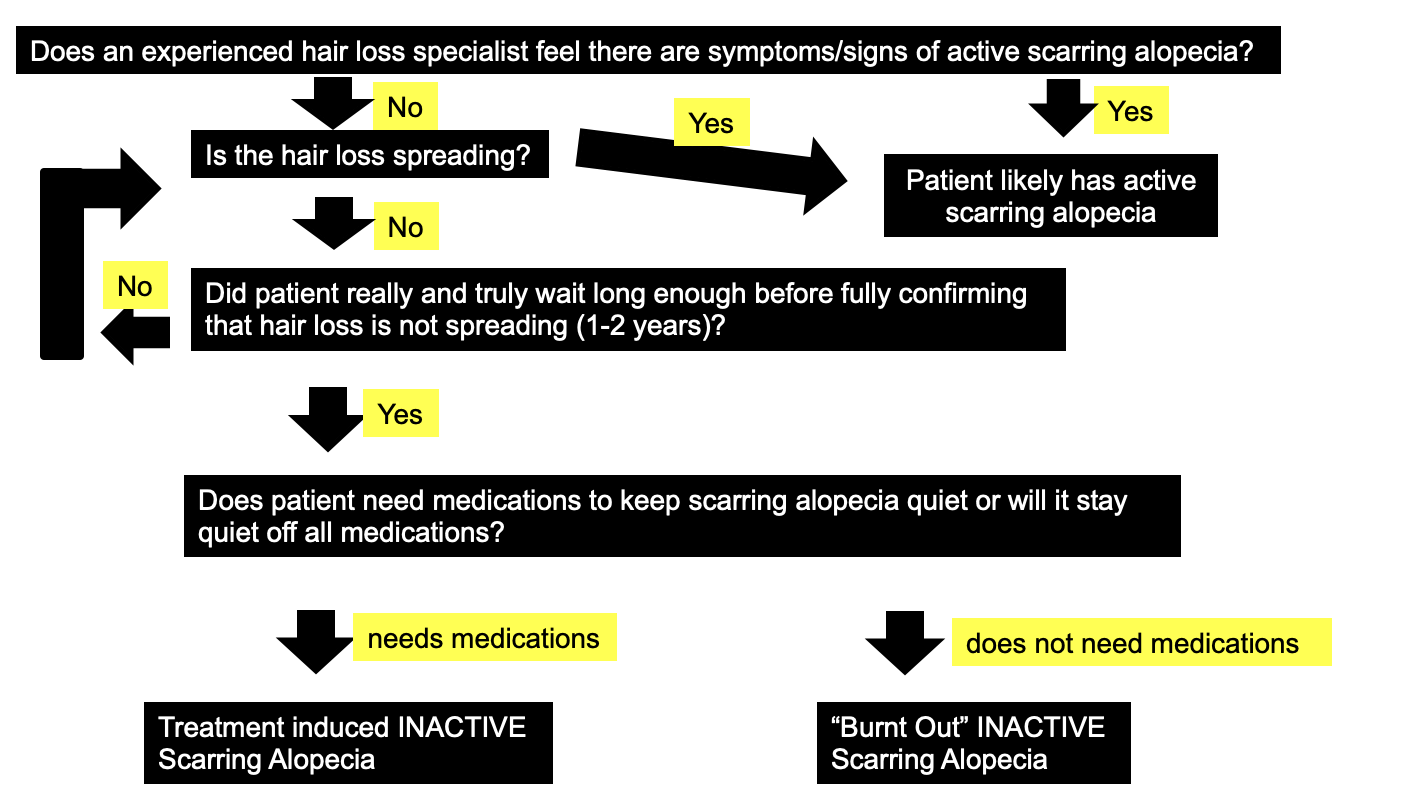Is my scarring alopecia "burnt out"?
Do you think my scarring alopecia is burnt out?
I’ve selected this question below for this week’s question of the week. It allows us to review some concepts related to inactive and burnt out scarring alopecia.
Question
I’m 45 year old female with lichen planopilaris. I have been using hydroxychloroquine, topical steroids, topical tacrolimus and cetirizine for 9 months… with good effect! I am happy to say that I no longer have itching or burning and shedding has returned to normal. Do you think it’s possible that I am burnt out now?!!! Hoping!
Answer
Thanks for the question. It’s certainly a really good sign that itching and burning are so much better and an equally good sign that shedding has improved. This is great!
However, I can not say with the information provided whether or not the scarring alopecia is inactive. It’s unlikely that it’s “burnt out” but I would need more information. it usually takes a bit longer for scarring alopecia to be truly “burnt out.” You and your doctors might wish to use this flow chart below to assess if your scarring alopecia is burnt out.
Proper assessment for scarring alopecia starts with evaluating symptoms and signs. Itching, burning and pain and shedding are possible signs of active scarring alopecia. But it’s not so simple. Someone can have itching and burning from seborrheic dermatitis instead of scarring alopecia so the simple fact someone has itching does not mean a person has active scarring alopecia. Similarly, someone can be shedding from COVID 19 or low iron instead of scarring alopecia…. so the findings of increased daily hair shedding also does not mean a scarring alopecia is necessarily active!
Similarly, someone can have no symptoms and no shedding but can have active scarring alopecia !!!
Tricky, isn’t it?
Just follow the flow chart below and you’ll see how this is possible.
So to review again, there are several things that happen has LPP becomes quiet. Itching and burning reduce (for those that actually have these symptoms to begin with). Redness reduces. Shedding reduces. Scale and redness around hairs also reduces (that may require an up close examination by your doctors).
But the one thing that must not be forgotten is that hair loss also stops when disease is inactive. That’s the key!
As a next step to determining if your disease is inactive, you’ll want to have proof that scale and redness have reduced (your doctor will help with that as you yourself can’t fully determine that). And you’ll want to prove that there has been no further hair loss. That’s trickier! You’ll need a good one year and ideally even two years to be really really confident of this. This means taking lots and lots of photos now and comparing an identical set in 1-2 years. If there is truly no change in any of the photos then there is a pretty good chance the disease is inactive.
If you put photos from 2024 out on the table and compare them to 2022 and they look identical in all ways… then it’s probably inactive! If the photo from 2024 shows a bit more eyebrow loss or a bit more loss in the crown … then we may be dealing with ongoing scarring alopecia. Of course, one can have hair loss from other reasons (androgenetic alopecia, etc) so it needs professional evaluation.
One of the problems with determining a disease is inactive, is that patients and doctors don’t wait long enough before assessing that. In some forms of scarring alopecia that are mildly active it can take 12 months and rarely even 18 months before enough hair is destroyed by the immune system to see a difference on a photograph.
Not everyone with active scarring alopecia has redness, itching, burning and shedding. But everyone with active scarring alopecia will “eventually” lose some amount of hair. That timeline for what constitutes “eventually” ranges from 1 months to 4 years.
So photos are key!
To summarize, it’s possible your scarring alopecia is inactive. Again, I can’t say as I only have been given a small fraction of the total amount of information I would need to render an opinion. But if it is inactive, it’s not likely that it is burnt out. That’s a very special term that is frequently misused. Burnt out means that all medications can be stopped and the disease still stays quiet. I don’t think it’s very likely that you would be able to stop all medications tomorrow and be guaranteed that you would never had hair loss from scarring alopecia again.
Do keep in mind that there are two types of inactive scarring alopecia. One is medication induced inactive scarring alopecia (also called treatment induced inactive scarring alopecia). This is a situation whereby the scarring alopecia goes to sleep due to the medications that are used. Once medications are stopped the disease wakes up. That’s the most likely type you would have if indeed someone can prove your scaring alopecia is inactive.
The other type of inactive scarring alopecia is “burnt out” scarring alopecia. This is a very special form of inactive scarring alopecia and means that the disease is 100 % quiet - regardless of whether or not medications are being used. In burnt out scarring alopecia, medications can be stopped and the disease stays quiet. Medications have absolutely no effect on burnt out scarring alopecia because the disease is quiet.

